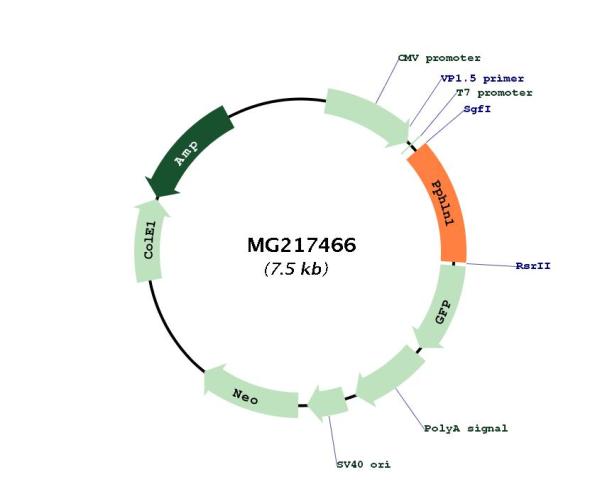Pphln1 (NM_175363) Mouse Tagged ORF Clone
CAT#: MG217466
- TrueORF®
Pphln1 (tGFP-tagged) - Mouse periphilin 1 (Pphln1) transcript variant 2, (10ug)
ORF Plasmid: DDK
Lentiviral Particles: DDK w/ Puro mGFP w/ Puro
AAV Particle: DDK
"NM_175363" in other vectors (3)
Specifications
| Product Data | |
| Type | Mouse Tagged ORF Clone |
| Tag | TurboGFP |
| Symbol | Pphln1 |
| Synonyms | CR; HSPC206; HSPC232 |
| Vector | pCMV6-AC-GFP |
| E. coli Selection | Ampicillin (100 ug/mL) |
| Mammalian Cell Selection | Neomycin |
| Sequence Data |
>MG217466 representing NM_175363
Red=Cloning site Blue=ORF Green=Tags(s) TTTTGTAATACGACTCACTATAGGGCGGCCGGGAATTCGTCGACTGGATCCGGTACCGAGGAGATCTGCC GCCGCGATCGCC ATGTGGTCTGAGGGACGCTATGACTACGACCGACTTCCGAGAGAACGCGTGCCTCCCCGGAGCCATCCCA GTGATGAATCTGGCTACAGATGGCTAAGAGATGATCATTCCACAAGCCGGCAGCCTGACTACAGGGACAT GAGAGACGGCTTCAGAAGAAAGAGTTTCTACTCTTCACATTATTCGAGAGATCGGTCTCCCCATAAAAGG GACGCTCCCTTCTTCAGAGAATCCCCTGTCGGCCGGAAGGACTCCCCACACAGCAGATCCGGCTCCAGTG TCAGCAGCAGAAGCTATTCTCCAGAGCGAAGCAGGACTCACTCCTTCCATCAGTCTCAGCATAGAAAGTC CTCGCGTGTCGGTGCTTCCTACAAACGACAGAATGAAGCAATTCGTGGAAGAGGTAAAGAGAGATCCATC CAGTCAGTGAAAACCTCGAGAGATGCGTCACCCTCAAGTTCCTCAGCAGTTGCTTCATCCAAGGCGTTAG ACAAACCCAGCAGGCTAACTGAGAAGGAACTTGCTGAGGCTGAAAGCAAGTGGGCTAATGAAACACTAGA GAAGTCAGACGAAAGTAACTTGGCTGAAATGAATGAGTTTGAGGCGGGATCCACGGCACCCTTATTTATT GACCAGACAGAAGAACCCGAGTCAAACACAGTAGATGGTACAGAACTGTATGAAGACAGCCAGCTCAGCA ACCGCTCTAAAGCCATTGCCTCGAAAACCAAAGAGATTGAGCAGGTTTACCGACAAGACTGCGAGACTTT CGGGATGGTGGTGAAAATGCTGATTGAAAAAGATCCCTCATTAGAAAAGTCTGTCCAGTTTGCACTGAGG CAGAACTTACACGAGATAGGTGAGCGCTGCGTGGAAGAGCTCAAGCGTTTCATTACTGAGTATGACAACT CTGCTCAGGACTTTGGAGACCCCTTT AGCGGACCGACGCGTACGCGGCCGCTCGAG - GFP Tag - GTTTAA >MG217466 representing NM_175363
Red=Cloning site Green=Tags(s) MWSEGRYDYDRLPRERVPPRSHPSDESGYRWLRDDHSTSRQPDYRDMRDGFRRKSFYSSHYSRDRSPHKR DAPFFRESPVGRKDSPHSRSGSSVSSRSYSPERSRTHSFHQSQHRKSSRVGASYKRQNEAIRGRGKERSI QSVKTSRDASPSSSSAVASSKALDKPSRLTEKELAEAESKWANETLEKSDESNLAEMNEFEAGSTAPLFI DQTEEPESNTVDGTELYEDSQLSNRSKAIASKTKEIEQVYRQDCETFGMVVKMLIEKDPSLEKSVQFALR QNLHEIGERCVEELKRFITEYDNSAQDFGDPF SGPTRTRRLE - GFP Tag - V |
| Restriction Sites |
SgfI-RsrII
Cloning Scheme for this gene
Plasmid Map

|
| ACCN | NM_175363 |
| ORF Size | 3825 bp |
| OTI Disclaimer | The molecular sequence of this clone aligns with the gene accession number as a point of reference only. However, individual transcript sequences of the same gene can differ through naturally occurring variations (e.g. polymorphisms), each with its own valid existence. This clone is substantially in agreement with the reference, but a complete review of all prevailing variants is recommended prior to use. More info |
| OTI Annotation | This clone was engineered to express the complete ORF with an expression tag. Expression varies depending on the nature of the gene. |
| Product Components | The ORF clone is ion-exchange column purified and shipped in a 2D barcoded Matrix tube containing 10ug of transfection-ready, dried plasmid DNA (reconstitute with 100 ul of water). |
| Reconstitution | 1. Centrifuge at 5,000xg for 5min. 2. Carefully open the tube and add 100ul of sterile water to dissolve the DNA. 3. Close the tube and incubate for 10 minutes at room temperature. 4. Briefly vortex the tube and then do a quick spin (less than 5000xg) to concentrate the liquid at the bottom. 5. Store the suspended plasmid at -20°C. The DNA is stable for at least one year from date of shipping when stored at -20°C. |
| Reference Data | |
| RefSeq | NM_175363.4, NP_780572.1 |
| RefSeq ORF | 939 bp |
| Locus ID | 223828 |
| UniProt ID | Q8K2H1 |
| Cytogenetics | 15 E3 |
| Gene Summary | Component of the HUSH complex, a multiprotein complex that mediates epigenetic repression. The HUSH complex is recruited to genomic loci rich in H3K9me3 and is probably required to maintain transcriptional silencing by promoting recruitment of SETDB1, a histone methyltransferase that mediates further deposition of H3K9me3. In the HUSH complex, contributes to the maintenance of the complex at chromatin. Acts as a transcriptional corepressor and regulates the cell cycle, probably via the HUSH complex. The HUSH complex is also involved in the silencing of unintegrated retroviral DNA: some part of the retroviral DNA formed immediately after infection remains unintegrated in the host genome and is transcriptionally repressed. May be involved in epithelial differentiation by contributing to epidermal integrity and barrier formation.[UniProtKB/Swiss-Prot Function] |
Documents
| Product Manuals |
| FAQs |
| SDS |
Resources
Other Versions
| SKU | Description | Size | Price |
|---|---|---|---|
| MR217466 | Pphln1 (Myc-DDK-tagged) - Mouse periphilin 1 (Pphln1), transcript variant 2 |
USD 300.00 |
|
| MR217466L3 | Lenti ORF clone of Pphln1 (Myc-DDK-tagged) - Mouse periphilin 1 (Pphln1), transcript variant 2 |
USD 600.00 |
|
| MR217466L4 | Lenti ORF clone of Pphln1 (mGFP-tagged) - Mouse periphilin 1 (Pphln1), transcript variant 2 |
USD 600.00 |
{0} Product Review(s)
Be the first one to submit a review






























































































































































































































































 Germany
Germany
 Japan
Japan
 United Kingdom
United Kingdom
 China
China

